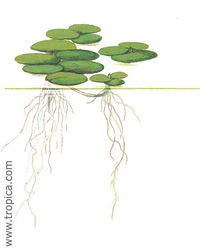Difference between revisions of "Limnobium laevigatum"
From The Aquarium Wiki
| Line 21: | Line 21: | ||
|placement = floating | |placement = floating | ||
}} | }} | ||
| + | |||
| + | == Description == | ||
| + | |||
| + | :A floating aquatic plant which bears a superficial similarity to the water hyacinth. Young plants grow in swirling rosettes which lie flat on the water's surface. A characteristic trait of the young plants is the presence of spongy aerenchyma tissue on the underside of the leaf. Adult plants produce small white flowers during reproduction. | ||
| + | |||
| + | They can reproduce both sexually via flowering and asexually via fragmentation of stolon segments. This ability to easily vegetatively reproduce enables them to have a huge capacity for quickly spreading over a large area. | ||
== Alternative Names and variants == | == Alternative Names and variants == | ||
Revision as of 14:19, 11 September 2020
| You can contribute to the Aquarium Wiki by expanding this article. Dont be shy!. |
Amazon Frogbit
Limnobium laevigatum
Floating
18 -28 °C (64.4-82.4°F)
Max Height
5 cm (2")
Max Width
25.4cm (10 ")
Contents
Description
- A floating aquatic plant which bears a superficial similarity to the water hyacinth. Young plants grow in swirling rosettes which lie flat on the water's surface. A characteristic trait of the young plants is the presence of spongy aerenchyma tissue on the underside of the leaf. Adult plants produce small white flowers during reproduction.
They can reproduce both sexually via flowering and asexually via fragmentation of stolon segments. This ability to easily vegetatively reproduce enables them to have a huge capacity for quickly spreading over a large area.
Alternative Names and variants
- Amazon Frogbit, South American Frogbit
Other similar species
- Hydrocharis morsus-ranae - European Frogbit
- Limnobium spongia - American Frogbit
Environment Specifics
- Requires good light, a mature tank preferably receiving fertilisation and slow to medium water flow.
Notes
- Very handy plant to give shade and security to small fish or fry. The long roots provide a growth medium for infusoria an important food for small fish.


